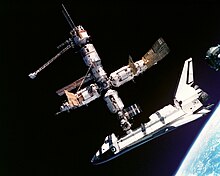STS-71
| Mission emblem | |||
|---|---|---|---|

|
|||
| Mission dates | |||
| Mission: | STS-71 | ||
| COSPAR-ID : | 1995-030A | ||
| Crew: | 7 started 8 landed |
||
| Begin: | June 27, 1995, 19:32:19 UTC | ||
| Starting place: | Kennedy Space Center , LC-39A | ||
| Space station: | Me | ||
| Coupling: | June 29, 1995, 13:00:16 UTC | ||
| Decoupling: | July 4, 1995, 11:09:42 UTC | ||
| Duration on me: | 4d 22h 9min 26s | ||
| Landing: | July 7, 1995, 14:54:34 UTC | ||
| Landing place: | Kennedy Space Center, Lane 15 | ||
| Flight duration: | 9d 19h 22min 15s | ||
| Earth orbits: | 153 | ||
| Rotation time : | 91.3 min | ||
| Apogee : | 385 km | ||
| Perigee : | 296 km | ||
| Covered track: | 6.6 million km | ||
| Team photo | |||
 v. l. No. Front: Wladimir Deschurow, Robert Gibson, Anatoli Solowjow; Back: Norman Thagard, Gennadi Strekalow, Gregory Harbaugh, Ellen Baker, Charles Precourt, Bonnie Dunbar, Nikolai Budarin |
|||
| ◄ Before / After ► | |||
|
|||
STS-71 ( english S pace T ransportation S ystem) is a mission designation for the US Space Shuttle Atlantis ( OV -104) of NASA . The launch took place on June 27, 1995. It was the 69th space shuttle mission and the 14th flight of Atlantis. During the third flight as part of the Shuttle Mir program , the first coupling of a US space shuttle to the Mir space station took place. It was also the 100th manned American space flight (according to US counts) and the 22nd manned mission to Mir.
team
Shuttle crew
-
Robert Gibson (5th space flight), commander

-
Charles Precourt (2nd space flight), pilot

-
Ellen Baker (3rd spaceflight), mission specialist

-
Bonnie Dunbar (4th spaceflight), mission specialist

-
Gregory Harbaugh (3rd spaceflight), mission specialist

Me crew outbound
-
Anatoly Solovyov (4th space flight), Commander Russia

-
Nikolai Budarin (1st spaceflight), flight engineer Russia

This was the third time that Russian cosmonauts flew in the American space shuttle, but the first time that a Russian space novice was part of the crew.
replacement
-
Yuri Onufrijenko for Solovyov

-
Alexander Poleshchuk for Budarin

Me crew return flight
-
Vladimir Deshurov (1st space flight) Russia

-
Gennady Strekalov (5th space flight) Russia

-
Norman Thagard (5th space flight)

When landing, eight instead of the usual seven space travelers were on board. This had previously only happened on the STS-61-A mission .
Mission description
A high point in the cooperation between the USA and Russia in space was the first coupling of a space shuttle with the Mir space station. Initially, Atlantis flew in a very low orbit in order to quickly reduce the distance to the station. After several course corrections, the space shuttle approached the station within about 14 kilometers. After another orbit of the earth, Commander Gibson reduced the orbit of Atlantis slightly so that it approached the space station from below. After another short stopover, the two spacecraft were coupled on June 29 at 13:00 UTC . Mir and Atlantis thus formed the largest artificial earth satellite to date. After checking the connection, the two commanders opened the hatches and greeted each other warmly.
The flight program subsequently included several interviews with various television and radio stations. Above all, the space travelers were busy with medical examinations and the transport of various materials in both directions. New equipment, such as B. SVET, a mini-greenhouse, in which root growth was studied in weightlessness, and water in the space station. Disused equipment and experimental materials, however, were stowed in the space shuttle, including a large number of blood, urine and saliva samples. The new crew of the space station, Anatoli Solowjow and Nikolai Budarin, also brought individually adapted spacesuits and seat shells for the docked spacecraft Soyuz TM-21 .
Most of the medical examinations took place in the Spacelab , which was located in the loading bay of the Atlantis. Here, further blood and tissue samples were taken, heart and lung function examined, the condition of the muscle and nervous system as well as the reaction and performance of the long-term flyers measured. To make it easier to adapt to gravity after landing, the program also included intensive training with a treadmill and a bicycle ergometer . A suit was also worn several times, which put a greater strain on the abdomen of the space travelers due to negative pressure ( Lower Body Negative Pressure ). A similar device had already been used on board the station ( Tschibis ). For the USA, these tests were the first investigations into longer stays in weightlessness since 1974. At that time, a flight record of 84 days had been set.
While casting off, the Atlantis was filmed from aboard the Soyuz TM-21 spacecraft. For this purpose, the cosmonauts Solovyov and Budarin disconnected their spacecraft 15 minutes in front of the shuttle and moved a few hundred meters away from the station. The Atlantis returned to Earth on July 7th with the long-term fliers Deschurow, Strekalow and Thagard and landed at the Kennedy Space Center in Florida.
See also
- List of manned space flights
- List of space shuttle missions
- List of Mir expeditions
- List of space exits
- List of spacemen
Web links
- NASA Mission overview (English)
- Video summary with comments of the crew (English)
- NASA video of Mission (English)


